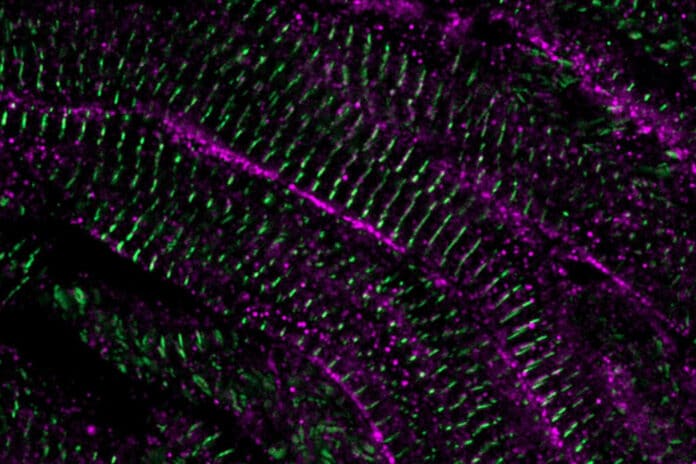Cardiovascular diseases, such as heart attacks, are a leading cause of death worldwide due to the heart’s limited ability to heal itself. However, zebrafish possess a remarkable regenerative capability to recover from cardiac damage.
Scientists led by Jeroen Bakkers from the Hubrecht Institute conducted research using zebrafish to uncover the secrets of their regenerative success. They made an intriguing discovery: newly formed heart muscle cells undergo changes in their calcium handling over time, and a factor called LRRC10 plays a crucial role in driving these changes. LRRC10 controls the decision-making process between cell division and maturation.
This finding was not limited to zebrafish but also had a similar effect on heart muscle cells in mice and humans, indicating an evolutionary conservation of the mechanism. The study, published in Science on May 18th, emphasizes the potential of studying natural heart regeneration in zebrafish and applying these insights to human heart muscle cells. These discoveries could pave the way for novel therapies to combat cardiovascular diseases.
Every year, approximately 18 million people lose their lives due to cardiovascular diseases. A significant number of these deaths are caused by heart attacks, where a blood clot blocks the flow of vital nutrients and oxygen to some heart regions.
Consequently, the affected region’s heart muscle cells die, eventually resulting in heart failure. While treatments are available to alleviate symptoms, no therapy can restore the lost tissue with fully functional, mature heart muscle cells, thus offering a cure for the patients.
Zebrafish are amazing creatures that can be a role models for humans. Unlike us, they have the incredible ability to regenerate their hearts. In just 90 days after sustaining damage, zebrafish can completely restore the function of their hearts. The surviving heart muscle cells have the special ability to divide and generate new cells.
This allows them to replace the lost heart muscle cells with fresh tissue. While previous studies have identified factors that can trigger the division of heart muscle cells, little was known about what happens to these newly formed cells afterward.
Phong Nguyen, first author of the study, explains: “It is unclear how these cells stop dividing and mature enough to contribute to normal heart function. We were puzzled by the fact that in zebrafish hearts, the newly formed tissue naturally matured and integrated into the existing heart tissue without any problems.”
To examine the maturation process of newly formed tissue, the researchers devised a method called live calcium imaging.
They cultured thick slices of injured zebrafish hearts outside the body. They observed the movement of calcium within heart muscle cells in real-time. The regulation of calcium plays a crucial role in controlling heart contractions and can indicate the cell’s maturity.
The study found that the rate of calcium movement in and out of the heart muscle cells changed over time after division. Initially, the calcium handling resembled that of embryonic heart muscle cells. However, gradually, the cells adopted a more mature pattern of calcium handling. Nguyen, one of the researchers, explains this progression in calcium handling during maturation.
The researchers made a significant discovery regarding the role of calcium in controlling the division and maturation of heart muscle cells. They found that a specific component called LRRC10, within the cardiac dyad structure, played a vital role during heart regeneration in zebrafish. Heart muscle cells without LRRC10 continued to divide and remained immature, while the expression of LRRC10 prevented cell division.
In previous studies, other factors were identified that led to uncontrolled cell division and the formation of enlarged hearts. However, LRRC10 also prevented the formation of these enlarged hearts, further highlighting its crucial role in determining both division and maturation processes.
Building upon their discoveries in zebrafish, Nguyen and his team aimed to investigate if the role of LRRC10 in halting cell division and promoting maturation could be applied to mammals.
They conducted experiments by introducing LRRC10 expression in mouse and lab-grown human heart muscle cells. Surprisingly, they observed that LRRC10 altered calcium handling, reduced cell division, and enhanced cell maturation, like in zebrafish hearts. Nguyen expressed excitement about these findings, as they suggest the potential use of LRRC10 in developing new therapeutic approaches for patients based on the knowledge gained from zebrafish research.
The interaction between calcium and sarcomeres plays a vital role in driving the maturation of cardiomyocytes during the regeneration process. This knowledge sheds light on the mechanisms behind heart tissue repair. It holds promise for developing effective strategies for promoting cardiac regeneration in the future.
Journal Reference:
- Phong D. Nguyen , Iris Goijers, etal. Interplay between calcium and sarcomeres directs cardiomyocyte maturation during regeneration. Science. DOI: 10.1126/science.abo6718
